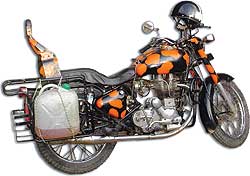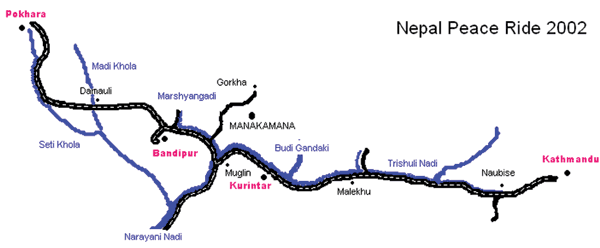 It took more than 15 years for me to consummate a love I first felt as a teenager studying in India. It took determination in the face of many nay-sayers, but ultimately it was worth the effort. I am talking about my infatuation with the Enfield motorcycle, that classic piece of beauty, the last word on lifestyle bikes.
It took more than 15 years for me to consummate a love I first felt as a teenager studying in India. It took determination in the face of many nay-sayers, but ultimately it was worth the effort. I am talking about my infatuation with the Enfield motorcycle, that classic piece of beauty, the last word on lifestyle bikes.
The most common arguments against the Enfield was the maintenance it would require, and its reputation as a fuel guzzler. But then "Why ride a bike when you can ride a legend" as the Enfield slogan went to counter the entry of the 100 ccs into India (and Nepal) in the 80s.
I took along a friend-an Enfield fiend, and owner, for more than 20 years-to get my 500 cc Royal Enfield Bullet from the showroom (yes, there used to be one such in Kathmandu). There was no way I was going to drive it out myself, for believe it or not, the nearest I'd ever been to handling a Bullet was when someone deigned to let me kick-start theirs way back when. I was also aware that it would take some time to get used to its heft and also to the awkwardness of the gear and brake levers being on the \'wrong' side.
Within half an hour, I was to get a taste of the famous Enfield temperament. Having shown off the beauty to another Enfield lover, I thought I'd take off on my own. Only, the machine simply refused to start. There were two of us kicking away (one has to have done that to appreciate the effort that goes into it), but we couldn't even coax a sputter out of the monster. As it turned out, the ignition mechanism was dead-in a bike that was showroom-fresh.
It was while figuring out what might have gone wrong with the bike that my friend passed on Canon No 1 of Enfield Ownership. "TLC," he said enigmatically.
"TLC?"
"Tender, loving care."
It was a rule I stuck by zealously. The bike was at the workshop every month. Since I had carted over spares from India on a series of trips, any worn part was immediately replaced. No one ever got to ride my Enfield, apart for short spins when I just couldn't say no. And I was being generous, for it is not just done to lend your Bullet, which also explains why the first one I rode happened to be my own.
Anyway, so there I was with my dream bike, complete with its steady 22 bhp engine, and nowhere to go other than the crowded Kathmandu streets. I was just raring to burn the tyres, do the \'born to be wild' thing. But the \'breaking-in' of an Enfield takes a tedious 2,000 km (compared to the usual 500 km in most bikes), and one can only putter along at a measly 50 kmph until then. 
When I did manage to venture out, it was with a lot of caution. You certainly don't want to have a dead 165-kg Enfield on your hands on the highway, which eventuality I was thankfully spared on all my long-distance trips. That probably had to do with being lucky, though the monthly check-ups my bike had to undergo could have been a factor as well. I did carry along all the necessary tools for emergencies, but with only the owner's manual to guide me, it was more as a reassurance than any ability of mine to tinker with the engine.
Steering around the twists and turns of our mountain highways is not the safest thing to do on a Bullet. The narrow tyre width and the fact that the double stand is slung very low can be dicey when taking the steep corners at high speed. But the bike comes to life in the tarai. You can't help but squeeze the accelerator. Zipping at 115+ kmph (I couldn't dare look at the speedometer after that, since the eyes had to be constantly peeled for any sign of animal or human life that might pop up on the road), watching slower vehicles diminish in the mirror as you urge the bike to go faster, and feeling smug that the bike can handle such speeds without a hint of a wobble, it was indeed an experience. Even though I was conscious all along that a crash would be, not to mince words, fatal.
The Enfield is stable. All you need to do is start the bike (a one-kick-start Bullet is much admired), roll it out of its stand, begin moving and it seems to balance all on its own. Especially useful for those quick zig-zag manoeuvres in the city, and emergency brakings.
More than its performance, however, the Enfield is better loved for two things. The classic old British bike look that has remained unchanged in style since it started being manufactured in India in 1955, and is now the only one in the world with such looks. The second is its distinctive sound, although for some reason it does not sound the same when you are riding it yourself. (The term used for motorcycles in eastern Nepal and Darjeeling, bhat-bhatay, must have been coined because of onomatopoeic representation of the Enfield sound.)
But the Enfield does have its drawbacks. A major one is the need for regular tune-ups. While talking about the Enfield an Australian once told me with the disdain only those from Down Under can feel for their mother country: "The Brits don't have a respect for mechanics." He was referring to the design of the bike's engine (not the grease-smeared individuals in garages), implying that had more attention been given to the science of mechanics, the Enfield wouldn't be such a headache to own.
I don't know much about that, but what I do know is that for all its power, the Enfield does not provide that extra burst of speed sometimes required in city driving. This was something I was to learn from near-death incidents in the early days of Enfield ownership when the bike simply refused to generate the power needed to avoid head-on collision as I tried to overtake, and show off to also I guess, slow pokes on the road.
Neither does the bike take so kindly to uphill climbs. It seems all that power is good only as long as the road is flat. Start up a hill, and you begin to wish your Enfield had the pull of a BMW.
The gear shift is generally quite unresponsive, and the neutral seems to appear at all places. The clutch is tough on the forearms, and in slow moving traffic where constant gear shifts become necessary, one can only be thankful that those long afternoons at the gym doing wrist curls are finally coming in handy. And, it's a veritable bone-shaker-the suspension system probably also dates back to 1955.
In the end, I just could not live up to my initial resolve to become a bike freak like most long-time Enfield owners are, i.e., do a little bit of pottering around on the bike on holidays. Work pressure, and perhaps a dash of natural disinclination meant either the bike had to visit the workshop with more frequency, or I had to part with it.
It was a cold morning that day as I watched this Dutch guy roar away into the dust, and I stood staring into the void that had been my Enfield. The love is not yet dead. I still feel it stirring deep within whenever I hear the thud-thud of a Bullet, and I seek out the sound and look-wistfully at the beauty that is the Enfield.


